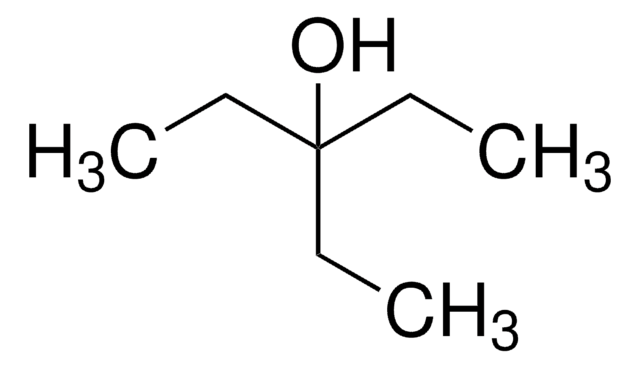Kluczowe dokumenty
109363
3-Heptanol
99%
Synonim(y):
Butyl ethyl carbinol
About This Item
Polecane produkty
Poziom jakości
Próba
99%
współczynnik refrakcji
n20/D 1.421 (lit.)
bp
66 °C/20 mmHg (lit.)
gęstość
0.821 g/mL at 20 °C
0.818 g/mL at 25 °C (lit.)
ciąg SMILES
CCCCC(O)CC
InChI
1S/C7H16O/c1-3-5-6-7(8)4-2/h7-8H,3-6H2,1-2H3
Klucz InChI
RZKSECIXORKHQS-UHFFFAOYSA-N
Szukasz podobnych produktów? Odwiedź Przewodnik dotyczący porównywania produktów
Powiązane kategorie
Opis ogólny
Zastosowanie
- Jako rozpuszczalnik do tworzenia mikrośrodowisk wokół jednościennych nanorurek węglowych.
- Do przygotowania podstawionych pochodnych pirymidyny jako analogów izoftalanu ukierunkowanych na domenę C1 w celu zbadania ich powinowactwa wiązania do izoformy PKCα.
- Jako budulec do syntezy pochodnych kwasu 4-(3-adamantan-1-ylo-ureido)-masłowego i kwasu cykloheksanokarboksylowego jako inhibitorów sEH.
Hasło ostrzegawcze
Warning
Zwroty wskazujące rodzaj zagrożenia
Zwroty wskazujące środki ostrożności
Klasyfikacja zagrożeń
Acute Tox. 4 Oral - Flam. Liq. 3
Kod klasy składowania
3 - Flammable liquids
Klasa zagrożenia wodnego (WGK)
WGK 3
Temperatura zapłonu (°F)
140.0 °F - closed cup
Temperatura zapłonu (°C)
60 °C - closed cup
Środki ochrony indywidualnej
Eyeshields, Faceshields, Gloves, type ABEK (EN14387) respirator filter
Wybierz jedną z najnowszych wersji:
Masz już ten produkt?
Dokumenty związane z niedawno zakupionymi produktami zostały zamieszczone w Bibliotece dokumentów.
Nasz zespół naukowców ma doświadczenie we wszystkich obszarach badań, w tym w naukach przyrodniczych, materiałoznawstwie, syntezie chemicznej, chromatografii, analityce i wielu innych dziedzinach.
Skontaktuj się z zespołem ds. pomocy technicznej









